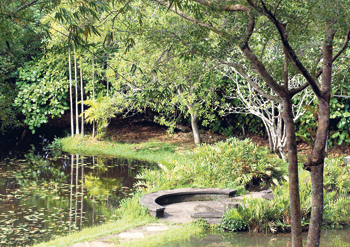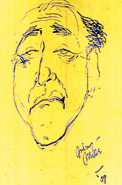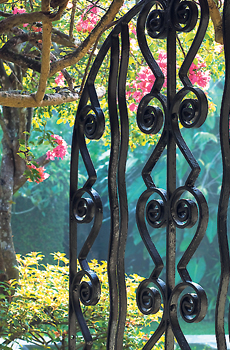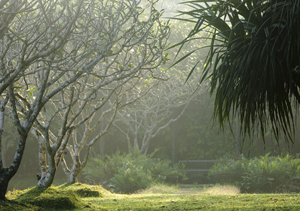In the ’70s, the distinguished architect Geoffrey Bawa threw a big garden party at his sprawling and celebrated home, Lunuganga. Taking his guests on a tour of his home and garden, he made an expansive gesture that seemed to suggest the surrounding countryside was an extension of his own grand property. Indeed, he was lord of his domain and beyond, proprietorial about almost everything in sight, all the way up to the green horizon. He then proudly told his guests about a small correction he had recently made to the view.
“There was this villager’s hut out there in the distance, and it had this hideous zinc roof that got on my nerves every time I looked out of my window,” Mr Bawa was saying. “An annoying little silver square squinting at me from that lovely sea of green. Most aggravating. I could tolerate it no longer, so I sent my chauffeur over to tell the house owner he would be doing me an enormous favour if he allowed me to cover his roof with red tiles – at my expense, of course. He agreed, and we are both happy!”
Like an artist with a paintbrush, Geoffrey Bawa deftly smeared a dab of earth-tone colour over a jarring metallic note and the tiny visual irritant in a corner of the canvas was gone.
 |
| Lunuganga: Black Pavillion |
My mother was one of the guests at that party 30 years ago, and she remembers Mr. Bawa’s comment as one of many interesting things he said that evening.
The late Geoffrey, like his brother the late Bevis, was an aesthete. Both men pursued beauty with a passion, and both dedicated their lives to the creation of beautiful things. Geoffrey designed houses, universities, hotels and resorts that have become architectural classics, while Bevis dabbled in art and sculpture and fashioned landscapes as a recreation and an occasional occupation.
And both men have left behind what may well be their most widely appreciated and lasting, certainly most evergreen, legacy – two flourishing, luxuriant artworks, the Bawa gardens in Bentota.
Bevis spent 40 years growing and shaping “Brief”, the 2.5 hectare plot of land on the southwest coast, north of the Bentota River, which was his home for the greater part of his life. The landscaped grounds were also a source of income from the many visitors who made a small contribution to see the famous garden. Brief became a popular tourist destination, and attracted an assortment of visitors, from Colombo residents to internationally famous writers, artists and royalty. It continues to attract crowds, 16 years after the owner’s death.
Inspired by Bevis’s home and landscaping venture, and not to be outdone by his older brother, Geoffrey bought an even larger property on the other side of the Bentota River, circa 1948, and laid out Lunuganga, a grand spread of a house and garden worthy of one of Asia’s most respected architects and landscapists. Brief is possibly the better known of the two gardens, because it was always an open invitation to guests; Lunuganga was a private property that was opened to the public only after Geoffrey Bawa’s death, in 2006.
 |
 |
“Though man delights in destroying plant life, I have never known plants to let down man.”
BEVIS BAWA |
“The garden had grown gradually into a place of many moods, the result of many imaginings.”
GEOFFREY BAWA |
| Sketches of Bevis and Geoffrey by Aubrey Collette |
Both gardens are the subject of a splendid new coffee-table book, “Bawa – The Sri Lanka Gardens”, a publication that even seems overdue, considering the fame of the two featured gardens and their creators.
With a text by David Robson and photographs by Dominic Sansoni, the book is an extension of previous related work by writer and photographer. Robson is the author of two magisterial studies of the architect’s legacy (“Geoffrey Bawa – The Complete Works” and “Beyond Bawa – Modern Masterworks of Monsoon Asia”), while Sansoni collaborated with photographer Christof Bon on the black-and-white tome “Lunuganga”, for which Geoffrey Bawa provided the text. The new book is the first major publication to give prominence to Bevis and his beloved Brief.
It is all too easy to overlook the text and focus on the visuals in a coffee-table book, especially one as beguiling to the eye as this one. But the reader who skips this text is missing out badly. There is much to enjoy and learn in David Robson’s well-researched material, rich in detail and anecdote, and while the content is scholarly, the writing is easy on the mind and pure reading pleasure.
As in a guided tour with the perfect tour guide, the reader is gracefully led into the Bawa gardens by way of two richly informative introductory chapters, the first covering Sri Lanka gardens in general, historic and contemporary, and the second telling the fascinating story of the men behind the two gardens.
By going back to the ancient kings who ruled from Anuradhapura, Polonnaruwa and Kandy, and surveying the remains of royal palaces, and royal pleasure gardens, as well as boulder gardens and monastic gardens, the writer shows how the stones of Sri Lankan history have set a foundation for the Lunuganga layout. The widely travelled Geoffrey was also influenced by gardens he saw during his student years in Cambridge, England, and his visits to China, Italy, and Spain, among many other countries.
Meanwhile, the equally widely travelled Bevis, who started out as a planter on a rubber estate in colonial Ceylon, was an admirer of the cosy interiors and picturesque surrounds of the British planters’ estate bungalows that dot the hills of Sri Lanka. This is reflected in the many charms of Brief.
 |
| Brief |
The Bawas – giants that they were in person, persona and talent – had a way of piqueing everyone’s interest; curiosity about their work and life has always been high.
The second chapter tells the colourful Bawa family story, and is generously adorned with old family album prints and sketches and cartoons by artists such as Aubrey Collette, Donald Friend and Bevis Bawa himself. The account is a fascinating social history, going back to mid-19th century Ceylon, when Geoffrey and Bevis’s grandfather, Ahamadu Bawa, married his French Huguenot wife, Georgina Ablett.
Entrusting the visual part of the book to Dominic Sansoni was a happy decision. Not only is he possibly Sri Lanka’s most high-profile lensman, eminently qualified to take on a project of this kind, he is also, through his family, closely associated with the Bawas, and knows the two gardens intimately. The Sansonis have been regular visitors to Bentota. The photographer has idyllic childhood and teen memories of exploring the mossy wonderlands of Brief and Lunuganga, packed with leafy secrets and arboreal delights. The Sansoni and Bawa connection goes back almost seven decades. The photographer’s father Hilden Sansoni was an officer in the Navy, while Bevis Bawa was a major in the Army, and both took turns as aides-de-camp to a succession of British governors.
The photographer’s mother, Barbara, along with the Australian artist Donald Friend, designed a series of terracotta tiles which decorate a section of Brief.
Sansoni welcomed the Bawa assignment. “My brief with Brief, so to speak, and Lunuganga was to illustrate a text, a book about gardens,” Sansoni says. “Nothing more, nothing less.”
 |
| Brief: East of house Spanish court |
There was also the responsibility of doing justice to two people who were good family friends and who held to the highest artistic standards. “I could feel the spirits of GB and BB looking over my shoulder every time I used my camera,” he says. “Would they approve, I kept thinking.”
Sansoni says the Bawa brothers were as different as two siblings could be. Geoffrey was formidably intellectual and reserved; many found his presence intimidating. Bevis was genial, gentle, avuncular, a “darling man”. If they disapproved, the responses would be markedly dissimilar. “If Geoffrey didn’t like something, you knew it. There would be this Great Silence, capital G, capital S. If Bevis didn’t like something, he’d let you know, but in the nicest way.”
It is hard to imagine either brother faulting the impeccable, sumptuous and handsome treat that Dobson, Sansoni and the Thames and Hudson publishing team have put together. Leafing through the book, up in his study at the back of Barefoot (the gallery-cum-shop-cum-restaurant-cum-hangout-cum-performing arts space that serves as his alternate home), Sansoni relives the experience of working on the project.
“It had a lot of personal significance for me, of course. Geoffrey and Bevis were dear friends. But this was work, and I was not aware of emotion or sentiment getting in the way. The project took several months, and umpteen trips to Bentota. Often I would stay overnight and start work early the next day, at first light.”
Light, or rather the contrasting of light with shade, are uppermost in Sansoni’s mind when he is prospecting for a golden photo moment. His preferred times for outdoors photography are early morning and twilight, when the shadows are just about to dissolve or congeal.
As we turn the pages, he points to pictures that satisfy him: single and double-page spreads of dappled vegetation, vistas of water and foliage and sweeping lawn shadowed by trees and bushes, and glimpses of statues and paved paths, all seen from various points in the two gardens and houses, with verandas, pillars, pergolas, loggias and pavilions playing visually supportive roles.
 |
| Lunuganga: The Broad Walk |
“Contrast with light and shade gives you a more three-dimensional image, and that depth invites you into the photograph. I like the idea of the reader wanting to reach out for a tree branch or enter the gardens and walk up a path.”
The interiors of Lunuganga and Brief – filled with art, statues and gleaming antique furniture – are also amply documented.
The writer Michael Ondaatje once described the Bawa gardens as “self-portraits”. The subjects of these dual family portraits are gone, but we will look at both men as mirrored in the beauty of their work with nature, and we will continue to do so as long as the gardens are cared for and allowed to flourish, and the environment protected.“Bawa – The Sri Lanka Gardens” is a reminder of how paradisal this country is. It is also a gentle nudge to the ecologically indifferent who may forget just how fragile this natural wealth and beauty is becoming. |






